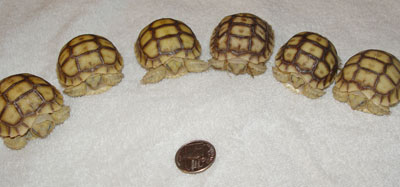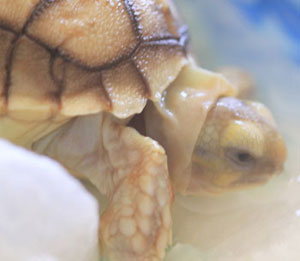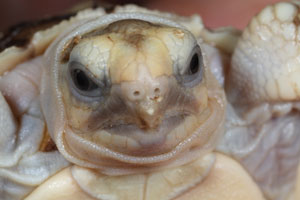
Juvenile Tortoises
Housing | Soaking | Temperatures | Metabolic Bone Disease |
MBD and Pyramiding | Oxalates | UVA/UVB | Humidity |
Diet | Final Thoughts | Disclaimer
As human beings we are fascinated by animals and feel a great need to keep them as pets. To satisfy our selfish personal needs to own a pet, we acquire said animal. Sadly for the animal, most of the time this is done without regard to their needs or any knowledge of their natural habitat. They often end up in less than satisfactory conditions.
 Example: sulcata tortoise hatchlings are so cute we just have to have one. So, from the pet store, from the reptile show, from a breeder, sometimes through an adoption, we make the acquisition. So begins the artificial habitat, diet and husbandry.
Example: sulcata tortoise hatchlings are so cute we just have to have one. So, from the pet store, from the reptile show, from a breeder, sometimes through an adoption, we make the acquisition. So begins the artificial habitat, diet and husbandry.
The following suggestions, statements and opinions are based on twenty-five years of hands-on experience and research. The sole purpose of the Ojai Sulcata Project is to help keepers of sulcata tortoises provide better husbandry in captive environments. There is entirely too much outdated care information being dispersed to keepers. You may not agree with my point of view, but at least keep an open mind for the animals’ well-being.
I have put more detail in the Juveniles section than in other sections of this web site. Good or bad – this is where it all starts. This is the most important time to get it right. You do not get a second chance. Our pets have to live with the results of our bad husbandry the rest of their lives.
Housing
Never use an aquarium for housing! The tall glass walls magnify heat, and there is not enough air circulation. There is not enough space for the tortoise to escape the heat in order to thermoregulate its body temperature and cool off.
I do not usually recommend particular brands, but I do like the ZooMed Tortoise House, available from Amazon.com for about $85.00. It measures 36" x 24" x 12", and is well-built with a sturdy wire lid that locks, separate sleeping area and designed to put two together as needed. The high sides make it a little easier to control humidity. I like it much better than the converted book-case enclosure. If you do use one, I suggest putting a waterproof barrier in the bottom and adding handles to carry it outside as weather permits. You can place the tortoise house on a flat wagon and take it outdoors easily.
Soaking
Routinely soaking sulcata tortoises is wrong and unnatural. Soaking should only take place if there is a specific medical reason for doing so. The reason soaking is recommended by some, as I understand it, is to prevent pyramiding, an abnormal distortion of the tortoise’s carapace that is characterized by deformed, pyramid-shaped scutes.
The typical recommendation is that the tortoise soak in shallow warm water for 15 to 30 minutes anywhere from once a day to multiple times a day. I find no scientific research to support the idea that soaking the plastron really does anything to stop pyramiding.
What does happen frequently is that the animal defecates in the water when soaking. If this happens several times a day or several times a week, you are interfering with the animal’s natural digestive transit time. The food is passing through the gut too quickly. Bad husbandry hinders the fermentation time needed to obtain the ultimate value of all the nutrients.
Keep a pan or saucer of water at the cool end of the enclosure; the tortoise will use it when it needs to drink or wants to soak.
Soaking is an unnatural, artificial solution to an unnatural, artificial problem caused by unnatural, artificial husbandry and habitat! In fact, this may well be a contributing factor to pyramiding. The scutes (keratin) absorb a lot of water and become very soft. The expansion and contraction of the keratin causes a lot of stress on the underlying bone. In an indoor enclosure, if the habitat temperature is high and the humidity is too low, the keratin can contract (dry out) too fast, causing the carapace bone structure to be drawn upward. The more dry the keratin becomes, the thicker it becomes, so up it goes, creating more stress to the carapace bone to follow. Get the temperature and humidity under control!
Temperatures
This is a common recommendation that appears on care sheets and internet web sites: “Minimum temperatures 60°F (16°C) at night and at least 95°F (35°C) degrees during the day.” This is wrong and unnatural!

Temperatures in the native habitat of the sulcata tortoise often drop well below 60°F. Turn off the heat and light at night; the tortoises need the cool, dark period of time to simulate their natural cycle.
Purchase a digital temperature reader and a timer-thermostat for a ceramic heat emitter (CHE) heat source, such a Pearlco brand ceramic heat bulb. First thing in the morning, put breakfast in the enclosure. Turn on the CHE, note the time you turned it on, and observe how long it takes for the tortoise to become active. Check the temperature of the carapace and do this at least a week. You are establishing a comfortable temperature range for the tortoise to eat and exercise. Set the timer/ thermostat to maintain the tortoise’s comfort zone for the day, about 80 to 85°F (27 to 29°C) and turn the CHE off at night. Always provide thermoregulation areas, so the tortoise can cool down or warm up as needed.
Metabolic Bone Disease
Metabolic bone disease (MBD) is another result of an unnatural, artificial environment, diet and light and questionable husbandry. MBD is a very complex disease characterized by abnormalities of the bones caused by a broad spectrum of disorders, most resulting from poor diet and bad husbandry. MBD should not to be confused with pyramiding. Causes and consquences of MBD include the following: inappropriate ratios of calcium to phosphorus, foods containing high oxalate content, incorrect UVA/UVB lighting, low vitamin D, low protein, and sometimes liver, kidney and thyroid disease.
Calcium:phosphorus ratio should be 2:1. If the calcium level in its diet is too low, the body will start taking calcium from other parts such as the bones. This causes the bones to soften and the body starts to build fibrous tissue to strengthen the bone in absence of the available calcium.
The calcium-phosphorus ratio is controlled with proper diet, not supplements. Cuttlefish bone is a good source of natural calcium. Be sure to remove the backing. Soaking the cuttlefish bone helps a little to remove the backing, which is not digestible and could get stuck in the juvenile tortoise’s gut. Metabolic bone disease is preventable with good husbandry, correct diet and environment.
Metabolic Bone Disease and Pyramiding
MBD is caused by improper diet; pyramiding is the result of improper environmental factors. If concurrent, MBD can be a contributing factor in pyramiding, because the bones have become softened from the low calcium intake. It is easier for the pyramiding scute to draw the softened bone upward. Without the resistance of the healthy underlying bone, pyramiding accelerates rapidly.
Pyramiding never goes away. Mild pyramiding will become less noticeable when environmental and dietary factors are corrected and the carapace grows larger. Longevity depends on the severity of pyramiding. All of the really bad cases I have rescued only lived 8 to 10 years. The internal organs keep growing, and because the skeletal cavity is deformed, the organs become crowded. The organs start to fail, and the ever-increasing pressure against the lungs eventually causes suffocation.
Oxalates
Most foods contain some oxalates; of course, some foods have a higher oxalate content than others. I cannot find established daily values to indicate how much oxalate is too much.
Here is one example: Pumpkin is high in oxalates, and its phosphorus content is higher than its calcium content, which is an improper ratio. Yet pumpkin is recommended as an acceptable food.
If you stick to a good long-fiber diet, with the proper calcium:phosphorus ratio (2:1), and the tortoise occasionally gets small amounts of other, less-balanced foods, it should not be harmful.
UVA/UVB and Vitamin D/D3 Deficiency
This is common recommendation: Tortoises need 8 to 14 hours a day of UVA/UVB light exposure to prevent Metabolic Bone Disease. This is wrong and unnatural.
 Natural sunlight is required, and is, without question, the best source of UVA/UVB rays, to help the animal make their own vitamin D and to synthesize it to Vitamin D3. Vitamin D and Vitamin D3 are vital to calcium metabolism.
Natural sunlight is required, and is, without question, the best source of UVA/UVB rays, to help the animal make their own vitamin D and to synthesize it to Vitamin D3. Vitamin D and Vitamin D3 are vital to calcium metabolism.
I cannot find any scientific studies establishing required dosages of Vitamin D3. Too much or too little can cause problems. Do not use supplements; provide natural sunlight only. Juveniles in the wild spend much of their young lives hiding from predators, getting at most dappled sunlight, and adults can go for weeks without any natural sunlight!
In my opinion UVA/UVB lamps are inefficient and unnecessary. Use the CHE for heating, and get the animal outside in dappled sunlight for a couple of hours, two or three times a week. Make sure to furnish water, shade and security (i.e., a hidebox, a covered enclosure, etc.) while the juveniles are outside.
If you do use a UVA/UVB light, purchase the very best available and continually measure the output. The effective output deteriorates very quickly; in some brands output is reduced within weeks. Use a timer and set it to come on for only about an hour and then shut off for the rest of the day.
Do not use the UV/heat combination units. The tortoise does not need that much UV exposure. Remember also these are very little, relatively delicate creatures.
Humidity
Here is another common recommendation: The tortoise needs high humidity, in the 80 to 90% range. This is wrong and unnatural.
Yes, they do need some humidity. Field research indicates that 45 to 50% is typical of levels in the wild. If you are keeping heat /UV fixtures on all day, maintaining humidity levels at 45 to 50% is almost impossible.
Purchase one or more humidity gauges. If the habitat is three or four feet long, get two, put one about six inches in from each end down close to the substrate, and protect the gauge from climbing tortoises. You need to measure the humidity percentage at the tortoise’s level, not the ambient percentage above their living area. The water dish may provide enough moisture to keep an optimal humidity level; if not, dampen the substrate area away from the CHE. Dampening the substrate should be all you need to do. Keep checking the humidity so it does not get too high (above 50%).
Diet
This is a common dietary recommendation: Feed your tortoises fruits, vegetables and store-bought greens and salad mixes. This is wrong and unnatural.

Provide natural foods such as grasses and various "weeds." Air-dry some of the grass and weeds and mix the dry food with the freshly-cut grasses and weeds. Avoid grocery store greens as much as possible. Refer to our diet page for recommendations for adult sulcata tortoises; the juveniles need the same types of foods.
Do not overfeed your tortoise; overfeeding can be a big part of the pyramiding problem. Feeding every other day is fine. The carapace (top shell) keratin by nature is always growing in a vertical direction. If the keratin is growing too fast it will pyramid. This stress will influence the underlying bone to follow the keratin. Bone is somewhat malleable, "capable of being altered or controlled by outside forces." If the keratin, the outside force, is too dry and too thick, or growing too fast, the stress to the slower-growing bone is overwhelming and pyramiding is the result.

Feed the tortoise in different places in its enclosure to encourage it to “forage” for its food. Put small amounts in different areas. Sulcata tortoises by nature are grazing animals, and they need the exercise.
If you have a small habitat area, place barriers jutting out from the sides of the enclosure so the tortoise gets more exercise as it moves around the barriers. Do not use barrier objects the tortoise can climb on and flip itself over. This barrier method works indoors and outdoors. You want the tortoise to have to walk around the barrier, increasing the amount of exercise it gets.
If you are in a cold climate and your tortoise slows down when the weather cools, you need to provide good long-fiber foods for the nutrition and warmth of the fermentation process. I have found Bermuda hay to be the best winter food. The digestive period will take a week or longer, depending on the temperatures.
If you have your juveniles on the right high-fiber diet, check their plastron temperatures and see if the plastron is a little warmer than the top of the carapace.
Final Thoughts
If you must have one or more of these majestic tortoises, please do your homework. Find out as much as you can about their natural habitat in sub-Saharan Africa, including their natural foods, temperatures and humidity levels.
Remember that these tortoises were never meant to be domestic pets or to live indoors. They are small to start with, but can grow to over 200 pounds (91 kilograms) in a few years. They need a lot of space; these are not backyard animals. Please consider the needs of the animal over your wants.
Important note: Never leave small children unattended around full-grown sulcata tortoises. Adult males, and some adult females, can be extremely aggressive, ramming people and causing injuries.
My wife suffered a broken tailbone from being knocked down. My young granddaughter was rammed and knocked down. Before I could reach her or the tortoise, he rammed her again and caused a lot of bruising.

Check for the latest scientific studies. Pay close attention to your animal, as this can help you determine some of its needs. If your sulcata tortoise is not doing well, or you see behavioral changes, reexamine your husbandry. Make a checklist of everything – housing, substrate, diet, environment/habitat, temperatures, humidity, heat, lighting, sunshine – check it all and make adjustments as needed. Remove as much of the "wrong, unnatural and artificial" as you can.
The bottom line is we still do not know all that makes the sulcata tortoise tick. My hope is that our Ojai Sulcata Project will improve our captive care husbandry, and the keepers and animals alike will benefit. Let’s abandon outdated information as we keep researching, sharing and applying our best husbandry practices for our animals' good health.
Disclaimer
I am not a veterinarian, and I am not dispensing medical advice. The information in the web site is presented for informational purposes only. If you think your tortoise is sick or has been injured, consult a qualified reptile veterinarian immediately.

